Beltane
In Celebration of Spring
Marie Edwards
Some of us may celebrate the Spring and our move through to the onset of Summer by following religions such as Christianity, Islam, Buddhism or follow Shamanic practices or Pagan traditions. We can even choose to create our own personal ceremonies or gatherings within our communities. Here we will look at just one of our traditional seasonal celebrations here in the UK, Beltane.
Beltane honours our transition from Spring to Summer; one of the mysterious ‘spaces between’ seasons which is usually celebrated in early May. Some view April 30th as the opposite phase to Halloween or Samhain which is acknowledged on the 31st October as we move from Autumn into Winter. At this fresh, blossoming stage in the year we are stepping towards the richness, potency and vibrancy of life experienced in Summer. The land has once again, awakened.
This is an ancient Gaelic festival that was celebrated by the Celtic people of Europe and many people who hold on to the power of seasonal traditions. In fact, there has been a huge revival of Beltane celebrations in the UK and beyond over the past few years and decades. As the leaves on the trees are unfolding, we are surrounded by the merry faces of spring flowers; the starry spread of woodruff; the blossom of hawthorn; we also witness the tentative emergence of baby animals such as lambs and fawns. Many of the prominent Beltane herbs and flowers are associated with the heart, particularly hawthorn which is used medicinally for a broad range of heart related ailments.
Beltane can loosely be understood as meaning, ‘bright fire’. ‘Bel’ also known as Belenus, Belenos or Belinus is the name of a Celtic God, a Sun God, ‘the fair shining one’ or ‘Shining God’. Bel was often depicted as riding the sun across the sky in a horse drawn chariot and is said to be the god of fire, light, health and wellbeing. To honour ‘Belenus’ on May Eve, tradition is to hold great fires on hilltops, which people dance around or jump over as a rite of purification. This welcomes the sun’s warmth and energy down to the earth, as we witness the merging of masculine energies (Father Sun) with feminine energies (Mother Earth); bringing forth new life. At Beltane we embrace the unification of spirit and matter.
Fertility rites and rituals have always been associated with Beltane and this is known to be nature’s ‘mating season’. We may well be feeling more creative or hopeful in terms of our outlook on life. As Glennie Kindred reminds us; “Beltain celebrates the fertility of the earth and the potency of the life force. When the union between the horned god and the fertile goddess was re-enacted by the women and men to ensure the fertility of the land.” Perhaps we are also acknowledging the union of the divine masculine and feminine energies that we all embody within; recognising the power of their integration externally in the natural world around us.
Beltane is also a time in which we also give thanks to our sacred, life giving water, wells, and springs. In the North of England and all over the UK there is a long history of well-dressing that has also seen a revival or continuation in practice in the recent past. Beautiful, intricate decorations and images are created on boards of clay adorned with living plants, flowers and petals. With the return or rebirth of these ‘old’ ways of celebrating our world we may find ourselves wondering if we are on the cusp of a global reembracing of the abundance of life and the potential for fertility and creativity our generous planet offers us.
We can choose to ‘Bring in the May, by gathering herbs and flowers bringing the fresh, renewed life force energy in to our homes and lives. As we acknowledge our move from Spring through to Summer, some say that the space between the material world and spiritual worlds is thinner. We may therefore find that we are more able to connect with shamanic or other spiritual practices at this time. However you choose to celebrate Spring and our transition into Summer, we hope that this period brings forth all that you desire and require for the months ahead.
Be ‘In-Tune’ with Nature
Krysia Soutar DipPermDes, Kushi Institute Level 2
In a temperate climate, we can observe that every season brings a change of energy, we are not separate from nature so we too should be aware of these changes and ‘go with the flow ‘.
Traditional society observed patterns of change throughout the year, Spring is the time of rising energy, we can see plants emerging after the long dormant wintertime. It is a time for new growth, and fresh activities. We plant our seeds and our ideas which have been forming in the deep winter. Time to start to emerge and become known.
It is a time to spring clean our homes and our bodies.
The Five Transformations
Ancient Chinese culture named the changes of energy as ‘The Five Transformations.’Spring is known as Rising Tree Energy.
The two organs associated with this time of year are the Liver and Gall bladder.During spring we can improve our health and wellbeing by looking after these organs.
How do we work with nature to assist these organs?
Nature shows us the way; early green leaves like ramsons or wild garlic; nettles; dandelion leaves providing a gentle cleansing of the liver. All greens and new sprouting greens allow the liver to relax and release fats.
Taste: The sour flavour is related to the liver, introducing more sour and fermented foods, such as sauerkraut and kimchi, lemon juice, good quality vinegars and garnishes with a mild hot taste such as spring onions and red and white (daikon) radish is helpful.
Emotions associated with Liver energy:
When the liver is functioning smoothly we are calm and have lots of patience. When the liver function is burdened by modern fast food industry practices of added fats, chemicals, hormones and un-natural methods of food production, with increased unnaturally fed animal and dairy products, and artificially refined sugar products - our liver suffers, as does the planet.
Everything is connected, what we choose to eat and how it is grown and produced will have consequences for us, for our children and the wellbeing of all future generations.
 |
|---|
| Wild garlic - a springtime treat |
 |
Leafy green vegetable tea
This drink is very relaxing and is said to help loosen stagnated protein and animal fats.
Ingredients:
- Half cup kale chopped finely
- Half cup other greens such as cabbage, watercress
- Pinch sea salt or a few drops of shoyu or tamari (I recommend Clearspring products for authentic natural quality)
Method:
- Wash and finely chop the greens
- Add twice the amount of filtered water
- Bring to boil gently and simmer for 3-5mins
- Add a pinch of sea salt or shoyu or tamari at the end and stir
- Drink the juice hot or at room temperature
Recipe Spring Vegetables "Quick–fix"
Ingredients:
- 4 cups cut bok choy
- 4 cups courgette sliced
- 2 cups bean sprouts
- 3tbs sesame or olive oil
- 1tsp ground black pepper
- Flaxseed oil
- Toasted sesame seeds
Cooking Method
Sauté bok choy in oil till the greens darken then add the courgette till the centres turn slightly translucent. Add bean sprouts and pepper and cook for an additional 5 minutes. Drizzle with some flaxseed oil and sprinkle toasted sesame seeds on top.
Recipe from: Macrobiotics for All Seasons by Marlene Watson–Tara
 |
|---|
| Hawthorn blossom |
 |
Hedgerow medicine
Edwina Hodkinson BSc(Hons)MNIMH - Medical Herbalist
Late spring; the days lengthen and the land is lush with the abundance of tree blossom, cow parsley and healing wild medicines. I walk down the lanes and breathe in deeply the aroma of May and stuff my basket with juicy cleavers and nettles ready to use in medicine, creams and food. The Hawthorn blossom is ripe for harvest, it’s white with a heady aroma, I nibble a few of the young buds and some of the flowers to use in tinctures and teas.
Nettle (Urtica dioica)
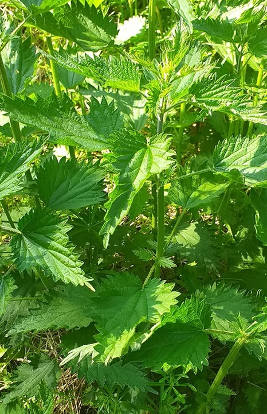 |
|---|
| Urtica dioica |
 |
This abundant plant with its famous sting is a firm favourite of mine.
It makes tasty nutritious food and is a powerful medicine with a multitude of uses. In spring the leaves make delicious, nutritious soups, beer and pestos and are a valuable tonic to the liver, kidneys, adrenal glands. It’s great to use with Elderflower and Plantain for managing hay fever and it also has a lot of use as an anti-inflammatory. Nettles can be used freshly chopped and infused in hot water in a tea or left overnight to really draw out its healing constituents, that are powerfully supportive in treating arthritis, skin problems, allergies and exhaustion. Many Herbalist’s value Nettle’s cleansing actions on the body as well as its use in the management of iron deficiency anaemia. The root is often used to treat a benign enlarged prostate and it’s a useful kidney tonic.
Many people I know love the seeds too, gathered fresh from the hedgerows in July and August, they provide an instant boost to energy levels, something that would have been of value to the country folk of the past in the busy months of the harvest. Take care to not exceed more than half a teaspoon though, as Nettle seed can be very stimulating especially when taken in the evening as a group of older ladies once found out on a herb walk. Dried, however, they become more mellow and can be very supportive to the endocrine system, especially to the adrenal gland, being a valuable aid in coping with exhaustion and burnout as well as a kidney tonic. There is even a folk reputation of Nettle seeds being an aphrodisiac.
Many people worry about the sting, but handled with gloves whilst picking and preparing, the fragile sting is then destroyed with heat. For those brave enough to try; The sting when used externally on painful and arthritic joints has a traditional use in pain relief which I know from personal experience is very effective.
Cleavers (Galium aparine)
 |
|---|
| Galium aparine |
 |
Cleavers are often found growing in hedgerows alongside nettles and can grow up to several meters high in mid-summer.
The leaves grow in whirls and when squeezed, produce copious amounts of bright green watery juice. Having the folk name of sticky willies or goosegrass, it often sticks to clothes and its burr-like seeds often getting caught in animal fur.
I spend a lot of time in spring juicing this plant for its cooling action, which can be used in juices and smoothies or added in equal amounts to glycerine to make a succus or to use in healing creams for irritated skin problems. It’s a useful herb for promoting lymphatic flow which can help rid the body of metabolic wastes, being useful in driving away the last of the winter colds, clearing swollen glands and supporting the kidneys and bladder. It makes a lovely salve with Aloe Vera gel added which is really good for hot irritated skin, burns, eczema and psoriasis, and my beautician sister tells me it great for helping to prevent wrinkles and sagging skin too.
Recipes
Cleavers Salve
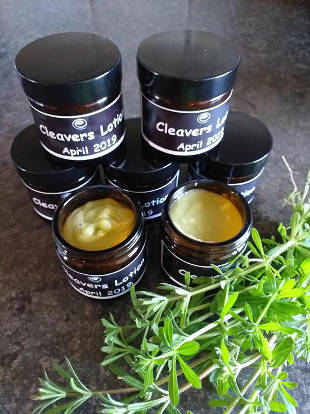 |
|---|
| Use cleavers to make a great salve |
 |
A fabulous lotion for hot, irritated skin (and wrinkles!)
- Chop a large handful of fresh cleavers, put in a bowl and cover with approx 250mls of sunflower oil.
- Place in a water bath, cover and leave to infuse on a low heat for a couple of hours.
- Strain and repeat the process with more chopped fresh cleavers, using the already green oil and re-infuse for a couple more hours.. compost the used cleavers.
- Strain and leave the oil in a bowl or jug overnight to allow any watery fluids to sink to the bottom and pour off the infused oil and measure.
- Put back in the bowl, for every 100mls of oil add 10g of beeswax and reheat until the wax melts.
- Take off the heat and leave to cool. When it's almost cool but not solid add an equal amount of pure Aloe Vera gel. Essential oils can such as lavender or frankincense can be added. Mix well. Pour in sterilised jars and label.
Hawthorn
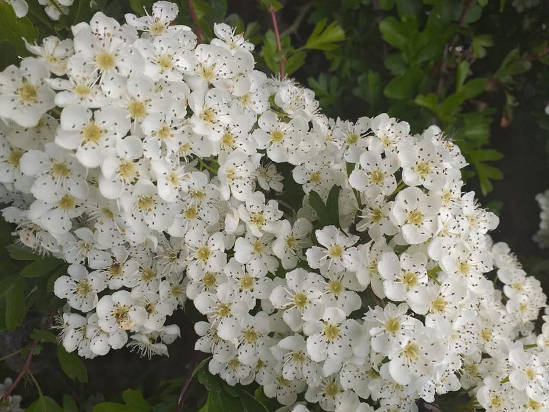 |
|---|
| Crataegus monogyna/Crataegus oxyacantha |
 |
Hawthorn is a tree steeped in legend and is one of the sacred trees of Celtic Myth. Native to the UK, this small, deciduous tree has rounded, lobed leaves that are deeply cut in parts. The flowers are white or pink and grow in clusters, Its blossoming signals the start of summer and is often associated with the old Mayday festival of Beltane.
Hawthorn is a herb of the heart and used extensively by Herbalists as a tonic for the cardiovascular system, where both flower, berry and leaves are used to strengthen the entire circulatory system, including the blood vessels and heart. Hawthorn opens up cardiac arteries and improves the blood flow. Increasing nutrition and energy uptake, it can also strengthen the heart muscle, helping it to work more efficiently. It has a tonic effect on large blood vessels as well as capillaries and can help normalise blood pressure, as well as increasing circulation to the fingers and toes. Hawthorn can also be helpful in reducing cholesterol and preventing the build-up of fatty plaques in the veins and arteries. It is ideal to use with older people coping with degenerative age-related changes of the heart and blood vessels and can help reduce the risk of heart disease and stroke. It is also extremely helpful with women going through the menopausal transition who need support with hot flushes, anxiety and palpitations.
Hawthorn has a calming effect on the body. It supports the nervous system and is good for stress and anxiety. Being good for the heart on many different levels, its good to use it to support someone coping with grief and loss.
Hawthorn can be used in many ways as both food and medicine. It can be made into a tonic drink with brandy or vodka, the blossoms and berries dried to use in a tea or it can be tinctured in Vodka with the berries added in Autumn to make a lovely healing medicine. Hawthorn is safe to use and non- toxic, but if you are taking any heart or blood pressure medication then you need to consult a herbalist or doctor.
Hawthorn flower tea
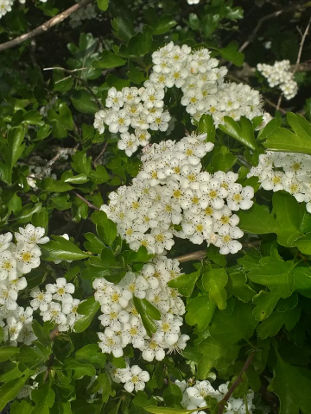 |
|---|
| Hawthorn flowers |
 |
Take a few of the lovely fresh blossoms and put in teapot. Add 300mls of hot water, cover and leave to steep for twenty minutes. Strain into a cup and enjoy.
Find out more from Edwina here
 |
|---|
 |
In the garden
Polyculture guilds for springtime
Teresa Pereira
Polyculture mimics the patterns we observe in healthy ecosystems and is fundamental to create ecologically balanced, resilient landscapes. This is the pattern used by permaculture gardeners and landscapers in order to generate increased yields and reduce external inputs, i.e. fertilisers and pesticides.
Polycultures are plants of different species grown in the same area. When these communities of plants share resources and form mutually beneficial relationships, they are described as guilds. Well-designed garden guilds yield more when planted together than they do apart.
These are the main benefits of plant guilds:
-
increased resistance to pests
-
lower levels of maintenance as plants meet each other’s needs
-
vertical layers increase yields in small spaces
-
provide habitats for wildlife
-
build soil over time
Let’s explore some design principles to keep in mind when we wish to create happy guilds of thriving plant communities that yield food, medicine, habitats and beauty:
-
maximise cooperation while minimising competition.
-
Minimise light, water and nutrients competition by spacing trees and shrubs so they don’t touch at maturity. In any planting area leave much less than 100% canopy cover. This way sunlight can reach the lower layers and plants on the ground can also maintain health and productivity.
-
In order to maximise cooperation in a guild include plants that perform these functions: fix nitrogen to feed each other, e.g. clover; dynamically accumulate nutrients overtime, e.g. comfrey; provide nectar and pollen to attract pollinators, e.g. bergamot; suppress ‘weeds’ with ground covers, e.g. strawberries.
-
-
To further enhance sunlight capture by all plants in a polyculture place taller plants at the back and shorter ones at the front, this is also aesthetically pleasing. As always, planting patterns that work are also elegant.
-
Whenever possible place edibles with similar harvesting periods close to each other, and allow adequate space between plants to make harvest easier. It is also important to design functional pathways to access plants to minimise soil compaction over time.
Here are a few examples of diverse scale polycultures, you can use these tried and tested garden ‘guilds’ to get started with confidence this Spring. These guilds need a sunny aspect and prefer a sheltered corner, plant facing South to Southwest. Happy planting!
medicine chest
The guild below has a variety of medicinal plants to make home remedies, plus it will attract pollinators and birds to the garden while also building soil.
 |
|---|
 |
berrylicious
This is the gift that keeps on giving. It needs a sunny corner, and will produce an abundance of berries year after year. Blueberries require acidic soil, so test the soil and amend if need be before planting. The alpine strawberries work a treat as ground cover, they are small but delicious, the intensity of fruiting will depend on how much sun they get. This guild prefers well drained soil.
 |
|---|
 |
Sheet mulching in Autumn is ideal to prepare for Spring planting. Don’t plant on heavy clay or compacted soils; take time to improve the soil, first by ripping, followed by adding organic matter.
Plant ground covers in early Spring, so they can get established before ‘weeds’ gain hold. There is nothing wrong with the plants we describe as ‘weeds’. They are tough and useful plants. When it comes to gardening, ‘weeds’ are plants in the wrong place at the wrong time in relation to our gardening intentions. Rather than ripping them out of the soil and dowsing it with chemical cocktails, permaculture gardeners prefer sheet mulching.
A sheet mulch can be as simple as cardboard, topped with straw, or it can be a more elaborate stack of soil building layers. The ’weeds’ are kept underneath and deprived of sunlight they compost in situ and further enrich the soil. You can then cut through the layers to plant shrubs and trees. When you don’t want to wait, add a layer of compost on top of the sheet mulched bed to plant ground covers. Otherwise, sheet mulched beds usually take one late summer, autumn and winter to compost all the layers and yield fertile soil.
Before you start planting, check in with this useful resource to find out the most fortuitous times to plant and harvest different crops in tune with the rhythms of the moon and other celestial bodies. Follow the wisdom of the biodynamic gardening calendar and your plants and soil will thank you for it.
Now, after all the hard work, enjoy the new polyculture islands in your garden, since the plants guilds are working to meet each other’s needs, they should only require minimal maintenance until well-established. This is when "the designer becomes a recliner" and can engage in quiet contemplation to the tune of the birds and the bees! Now, all there is to do is observe the results and wait for the harvest bounty.